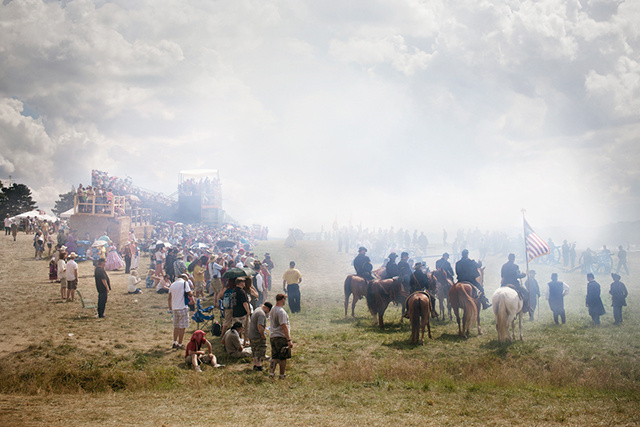Mossless in America is a column featuring interviews with documentary photographers. The series is produced in partnership with Mossless magazine, an experimental photography publication run by Romke Hoogwaerts and Grace Leigh. Romke started Mossless in 2009, as a blog in which he interviewed a different photographer every two days; since 2012 the magazine has produced two print issues, each dealing with a different type of photography. Mosslesswas featured prominently in the landmark 2012 exhibition Millennium Magazine at the Museum of Modern Art in New York; it is supported by Printed Matter, Inc. Its third issue, a major photographic volume on American documentary photography from the last ten years, titledThe United States (2003-2013), will be published this spring.
Advertisement

Eva O'Leary and Harry Griffin are photographers who work together. Last year they funded a project called Devil's Den using Kickstarter. For it, they photographed reenactors and spectators at the 150th-anniversary commemoration of the battle of Gettysburg. Juxtapositions within their images lay bare the differences between then and now. The project is featured in Mossless Issue 3, which is also currently on Kickstarter. We spoke with Eva and Harry about preconceptions drawn from history books, crowdfunding as a strategy for self-publishing, and the nature of collaboration.Mossless: What made you want to shoot the Gettysburg reenactment?Eva and Harry: The idea evolved from a shared interest. We had talked about collaborating before, but were waiting for the right idea. Some family had participated in the reenactment before, and they were talking about going again.Gettysburg is a town of 7,645 residents. Once a year, in the last week of July, approximately 50,000 people travel from all over the world to bask in the glory, fascination, and nostalgia of a war fought in 1863. This year was the 150th anniversary and was particularly huge.What surprised you most about it all?The first time we went to Walmart and saw a rebel sharpshooter buying toilet paper.History books, the internet, and word of mouth led us to Gettysburg with preconceived notions. The scale of the battle was impressive, but nothing compared to the spectators. They were incredible.
Advertisement
You funded your project through Kickstarter. What was that like?Raising money is hard! Without Kickstarter the project wouldn’t have happened. Devil’s Den was originally conceived as a book, and the money we raised was meant for production and printing. In the end, the pledges got us to Pennsylvania, allowed us to stay the full week, and gave us the financial freedom to make pictures. We're still in the process of getting the book published.What were your upbringings like?Eva: Both my parents are painters who met in grad school in Chicago. I was raised between two cultures, on little money, but was brought up with a sense of courage and belief in the currency of the arts. As a child I had two different identities: two accents and two last names. Half of each year was spent in Ireland, my mother’s country, where I was encouraged to reject my American DNA. I was a shapeshifter and sensitive observer, adopting the speech and body language of whatever country I found myself in.Harry: I was born and raised in South Florida, across the street from the Everglades. Part of my family devoted themselves to the film business, which is an obsessive and all-consuming career. When I was seven, my aunt cast me as an extra in Ace Ventura: Pet Detective, but the scene was cut. There was a time when I would watch my grandfather's films on VHS, both amazed and terrified by the content.How have cultural changes in the last ten years affected you personally?
Advertisement
Eva: Ireland has transformed completely from the country I knew as a child; it’s almost unrecognizable. I grew up amid the Irish banking boom of the 90s, a time of rapid growth and unbridled spending. For a brief time, it was the second richest country in the world. Last summer I returned to visit my family for the first time in 4 years. The contemporary landscape is different from what I remember as a child. There is a clear feeling of betrayal in the broken promise of capitalism. I'm left wondering how could a country that survived colonization, famine, and poverty be taken down by capitalist excess?Harry: My mom, a secretary to a plastic surgeon, lost her job last month. She’d been working there for 10 years and got fired for trying to save a life. Seeing her struggle as a 55-year-old single woman is fucked up. This is a seriously flawed system for people without trust funds.How does being a photographic team work?Working together came naturally. We know and respect each other's work and recognize each other's strengths and weaknesses. A hard realization came when we started showing the work online. What began as earnest excitement turned to frustration when attribution was given in predominance to one. It’s something you have to fight for, especially in the age of digital media.We both care deeply about the work and devote ourselves to it as much as our individual practice. Devil’s Den is split down the middle. We had two cameras, and we never disclose who took what. We got the idea from friends of Eva’s family, Ken Graves and Eva Lipman. They are a collaborative team who do the same.
Advertisement
What made you decide to combine forces?Mutual admiration and respect.FollowMossless magazine on Twitter and support their new book on Kickstarter.